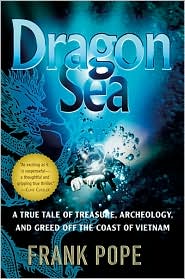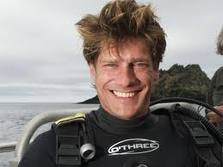“Just as the moon lures the tides, the ocean tugs at a man’s mind.”
In describing t he excavation of a junk which sank off the north coast of Viet Nam in the mid-fifteenth century, Frank Pope focuses on the people who engage in excavation work–the maritime archaeologist vs. the treasure hunter, the financiers who supply the funds that make underwater excavation possible, the looters (often fishermen) who damage sites, the academics who engage in fierce competition for recognition within the field, and the divers, who have to live underwater in small, pressurized containers for over a month at a time. He also includes the history of maritime archaeology, detailed descriptions of the equipment which has evolved to make deep dives possible, the status of current technology in the field, and the complex systems which support “saturation divers,” who may be working at eight atmospheres of pressure.
he excavation of a junk which sank off the north coast of Viet Nam in the mid-fifteenth century, Frank Pope focuses on the people who engage in excavation work–the maritime archaeologist vs. the treasure hunter, the financiers who supply the funds that make underwater excavation possible, the looters (often fishermen) who damage sites, the academics who engage in fierce competition for recognition within the field, and the divers, who have to live underwater in small, pressurized containers for over a month at a time. He also includes the history of maritime archaeology, detailed descriptions of the equipment which has evolved to make deep dives possible, the status of current technology in the field, and the complex systems which support “saturation divers,” who may be working at eight atmospheres of pressure.
The discovery of almost a million rare Vietnamese porcelain and ceramic artifacts from the fifteenth century represents less than half this book. Providing inside information about this excavation, the author sets up contrasts between this project, in which archaeologists map the site, set up grids,  and record and label every object, and the plundering done by treasure hunters whose sole objective is to take out and sell as many valuable artifacts as possible. The tense relationship between the financier of the project, who wants to recoup his investment, and those managing the project, who want to discover as much new information as possible, plagues the endeavor from start to finish.
and record and label every object, and the plundering done by treasure hunters whose sole objective is to take out and sell as many valuable artifacts as possible. The tense relationship between the financier of the project, who wants to recoup his investment, and those managing the project, who want to discover as much new information as possible, plagues the endeavor from start to finish.
The author is quite lyrical at the beginning of the book, explaining his own fascination with the undersea world and telling an imaginary story of the sinking of this ancient junk, but he soon begins to describe in great detail every aspect of this recovery project–and many other projects in which he and other members of the archaeological team previously took part. While this, and technical information, such as the photoluminescent testing of ceramics for dates and the history of diving helmets, will interest many readers, it delays the story of the excavation itself until halfway through the book, and readers expecting excitement may become impatient.
 The excavation itself is fascinating and filled with danger as a result of the financier’s refusal to use the safest (more expensive) equipment. A complete account sure to interest serious marine archaeologists, art historians, and those seeking the inside story of how one plans and conducts major maritime archaeological projects, the book is longer on detail than action. With its focus on the conflicting views within the field of preservation, however, Pope raises serious questions which the ironic conclusion intensifies.
The excavation itself is fascinating and filled with danger as a result of the financier’s refusal to use the safest (more expensive) equipment. A complete account sure to interest serious marine archaeologists, art historians, and those seeking the inside story of how one plans and conducts major maritime archaeological projects, the book is longer on detail than action. With its focus on the conflicting views within the field of preservation, however, Pope raises serious questions which the ironic conclusion intensifies.
Notes: The author’s photo appears on a site which specializes in filming underwater excavations. He is now investigating wrecks in the Thames in England. http://www.stephenfoote.co.uk/
